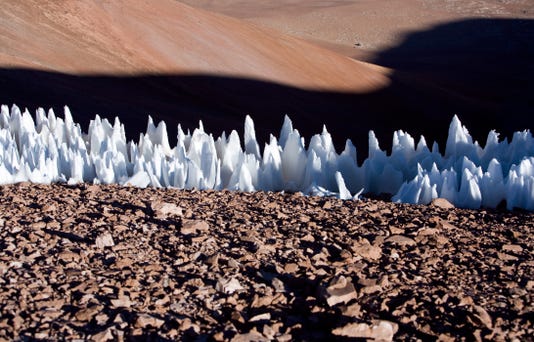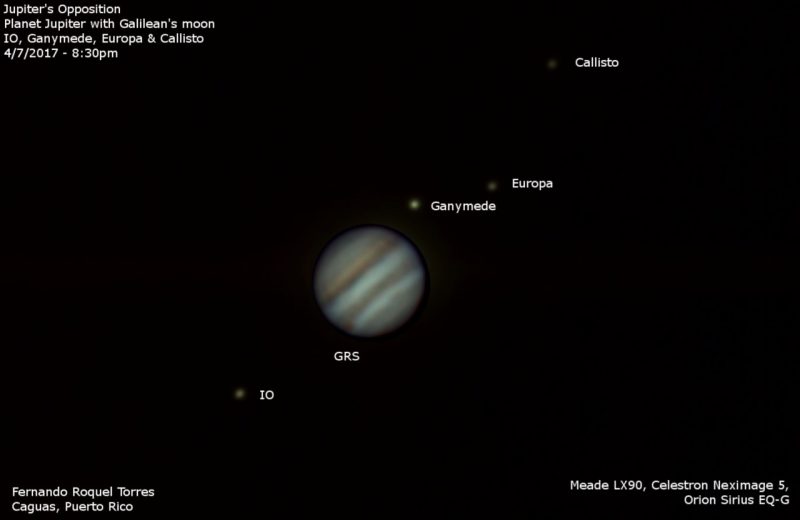


Terrestrial penitentes from the southern end of the Chajnantor plain, Chile, in 2005
The view is broadly northwards; blades can be seen perpendicular to the viewing direction. Image credit: ESO.

Posted on 10/09/2018 9:45:30 AM PDT by ETL
On Earth, the sublimation of massive ice deposits at equatorial latitudes under cold and dry conditions in the absence of any liquid melt leads to the formation of spiked and bladed textures eroded into the surface of the ice.
Known as penitentes, these sublimation-sculpted blades grow to between 3 to 16 feet (1-5 m) tall, but they are restricted to high-altitude tropical and subtropical conditions, such as in the Andes.
Europa, however, has the perfect conditions necessary for penitentes to form more uniformly — its surface is dominated by ice.
It has the thermal conditions needed for ice to sublime without melting; and there is very little variation in the angle in which the Sun shines on the surface.
In the new study, Cardiff University researcher Daniel Hobley and colleagues used observational data to calculate the sublimation rates at various points on Europa’s surface, and then used these to estimate the size and distribution of penitentes.
They concluded that the penitentes could potentially grow to around 50 feet tall with a spacing of around 25 feet (7.5 m) between each one.
It was also inferred that the penitentes would be more common around Europa’s equator.
“The unique conditions of Europa present both exciting exploratory possibilities and potentially treacherous danger,” Dr. Hobley said.
“The presence of sharp, blade-like structures towering to almost 50 feet high would make any potential landing mission to Europa extremely precarious.”
“We hope that studies like ours will help the engineers to develop innovative ways of delivering landers safely on Europa’s surface so that we can find out even more about this fascinating place, and potentially look for signs of extraterrestrial life.”
(Excerpt) Read more at sci-news.com ...



Terrestrial penitentes from the southern end of the Chajnantor plain, Chile, in 2005
The view is broadly northwards; blades can be seen perpendicular to the viewing direction. Image credit: ESO.



It should be called the Kavanaugh Ice Spike. LOL
New Horizons Spots Penitentes in Pluto’s Tartarus Dorsa Region
Jan 6, 2017
Enrico de Lazaro
http://www.sci-news.com/space/new-horizons-penitentes-plutos-tartarus-dorsa-04513.html
Terraformers will be calling for the elimination of ice!


![]()
It is also the sixth-largest moon in the Solar System.
Europa was discovered in 1610 by Galileo Galilei[1] and was named after Europa, the legendary mother of King Minos of Crete and lover of Zeus (the Greek equivalent of the Roman god Jupiter).
Slightly smaller than Earth’s Moon, Europa is primarily made of silicate rock and has a water-ice crust[11] and probably an iron–nickel core. It has a very thin atmosphere composed primarily of oxygen.
Its surface is striated by cracks and streaks, whereas craters are relatively rare. In addition to Earth-bound telescope observations, Europa has been examined by a succession of space probe flybys, the first occurring in the early 1970s.
Europa has the smoothest surface of any known solid object in the Solar System.[12]
The apparent youth and smoothness of the surface have led to the hypothesis that a water ocean exists beneath it, which could conceivably harbour extraterrestrial life.[13]
The predominant model suggests that heat from tidal flexing causes the ocean to remain liquid and drives ice movement similar to plate tectonics, absorbing chemicals from the surface into the ocean below.[14][15]
Sea salt from a subsurface ocean may be coating some geological features on Europa, suggesting that the ocean is interacting with the seafloor. This may be important in determining if Europa could be habitable.[16]
In addition, the Hubble Space Telescope detected water vapor plumes similar to those observed on Saturn’s moon Enceladus, which are thought to be caused by erupting cryogeysers.[17]
In May 2018, astronomers provided supporting evidence of water plume activity on Europa, based on an updated critical analysis of data obtained from the Galileo space probe, which orbited Jupiter between 1995 to 2003. Such plume activity could help researchers in a search for life from the subsurface European ocean without having to land on the moon.[18][19][20][21]
The Galileo mission, launched in 1989, provides the bulk of current data on Europa. No spacecraft has yet landed on Europa, although there have been several proposed exploration missions.
The European Space Agency’s Jupiter Icy Moon Explorer (JUICE) is a mission to Ganymede that is due to launch in 2022, and will include two flybys of Europa.[22] NASA’s planned Europa Clipper will be launched in the mid-2020s.[23]
The most massive of the moons are the four Galilean moons, which were independently discovered in 1610 by Galileo Galilei and Simon Marius and were the first objects found to orbit a body that was neither Earth nor the Sun.
From the end of the 19th century, dozens of much smaller Jovian moons have been discovered and have received the names of lovers or daughters of the Roman god Jupiter or his Greek equivalent Zeus.
The Galilean moons are by far the largest and most massive objects to orbit Jupiter, with the remaining 75 known moons and the rings together comprising just 0.003% of the total orbiting mass.
Of Jupiter’s moons, eight are regular satellites with prograde and nearly circular orbits that are not greatly inclined with respect to Jupiter’s equatorial plane.
The Galilean satellites are nearly spherical in shape due to their planetary mass, and so would be considered at least dwarf planets if they were in direct orbit around the Sun.
The other four regular satellites are much smaller and closer to Jupiter; these serve as sources of the dust that makes up Jupiter’s rings.
The remainder of Jupiter’s moons are irregular satellites whose prograde and retrograde orbits are much farther from Jupiter and have high inclinations and eccentricities.
These moons were probably captured by Jupiter from solar orbits. Twenty-seven of the irregular satellites have not yet been officially named.
Thanks ETL.
We’ll be the pirate twins again
?
Europa
Oh my country, Europa!
:format(jpeg):mode_rgb():quality(90)/discogs-images/R-2215941-1396561418-1262.jpeg.jpg)
The physics doesn’t work. You’d need about 30 more Jupiters to gob together just to get to red dwarf territory.
Man-made Global Warming?
“If you go to Z’ha’dum, you will die”
I would sure love to see a lander on Europa in my lifetime. Guaranteed to find all kinds of strange and interesting stuff.
Disclaimer: Opinions posted on Free Republic are those of the individual posters and do not necessarily represent the opinion of Free Republic or its management. All materials posted herein are protected by copyright law and the exemption for fair use of copyrighted works.